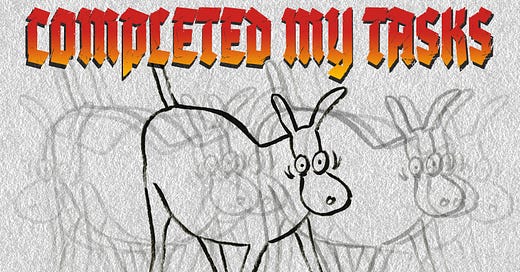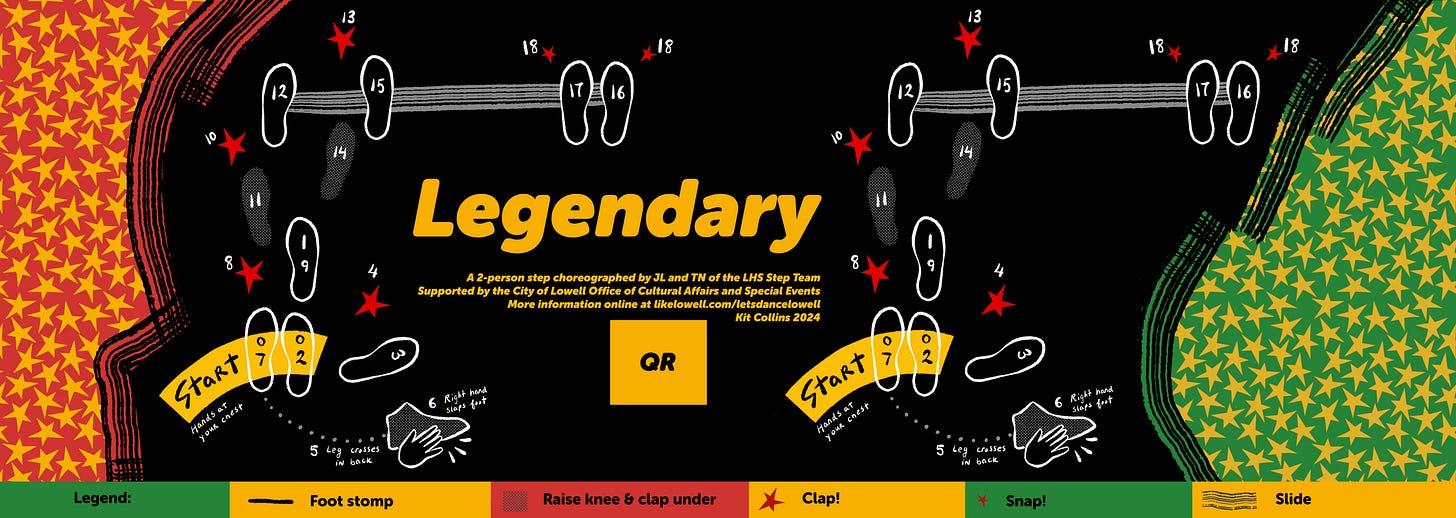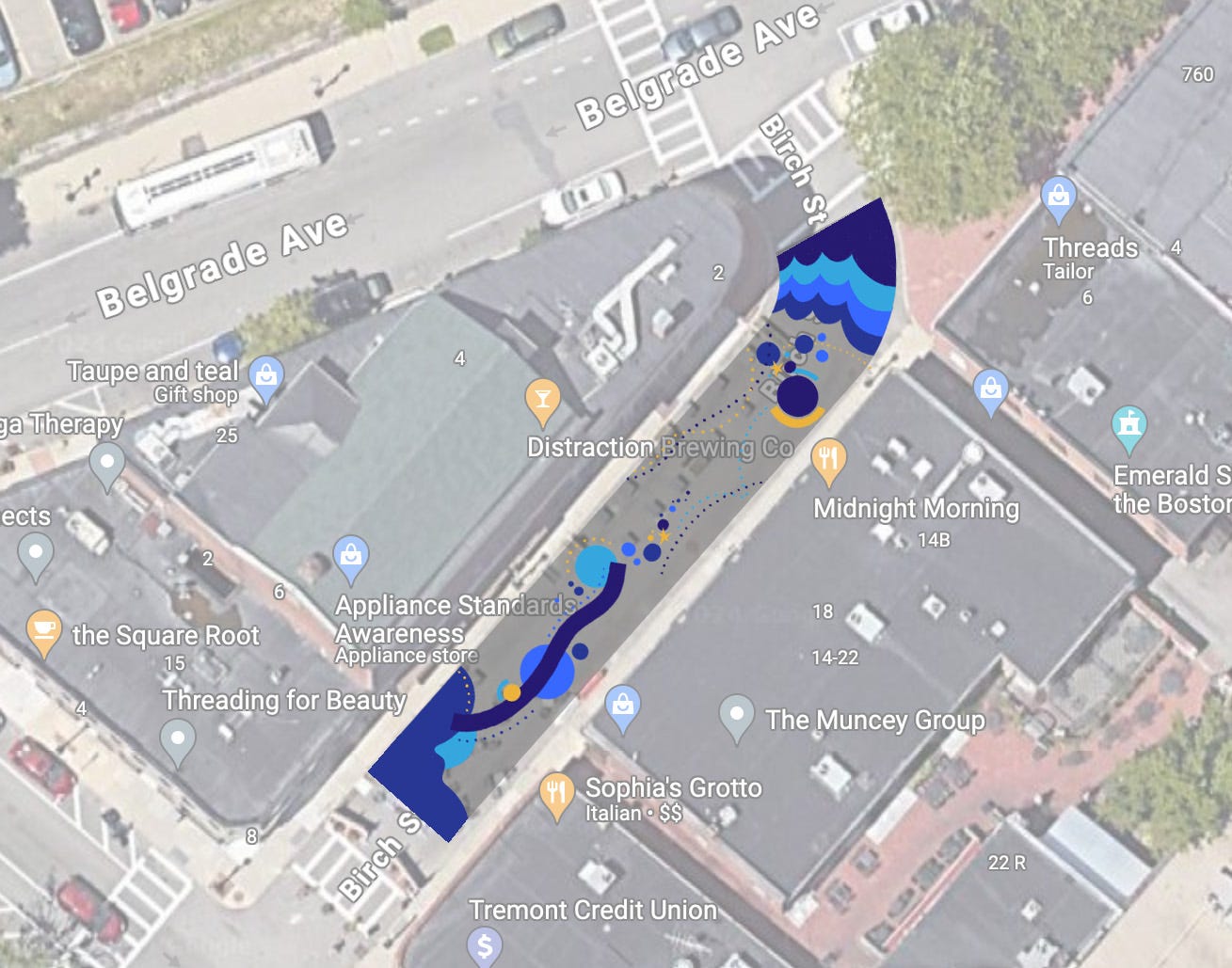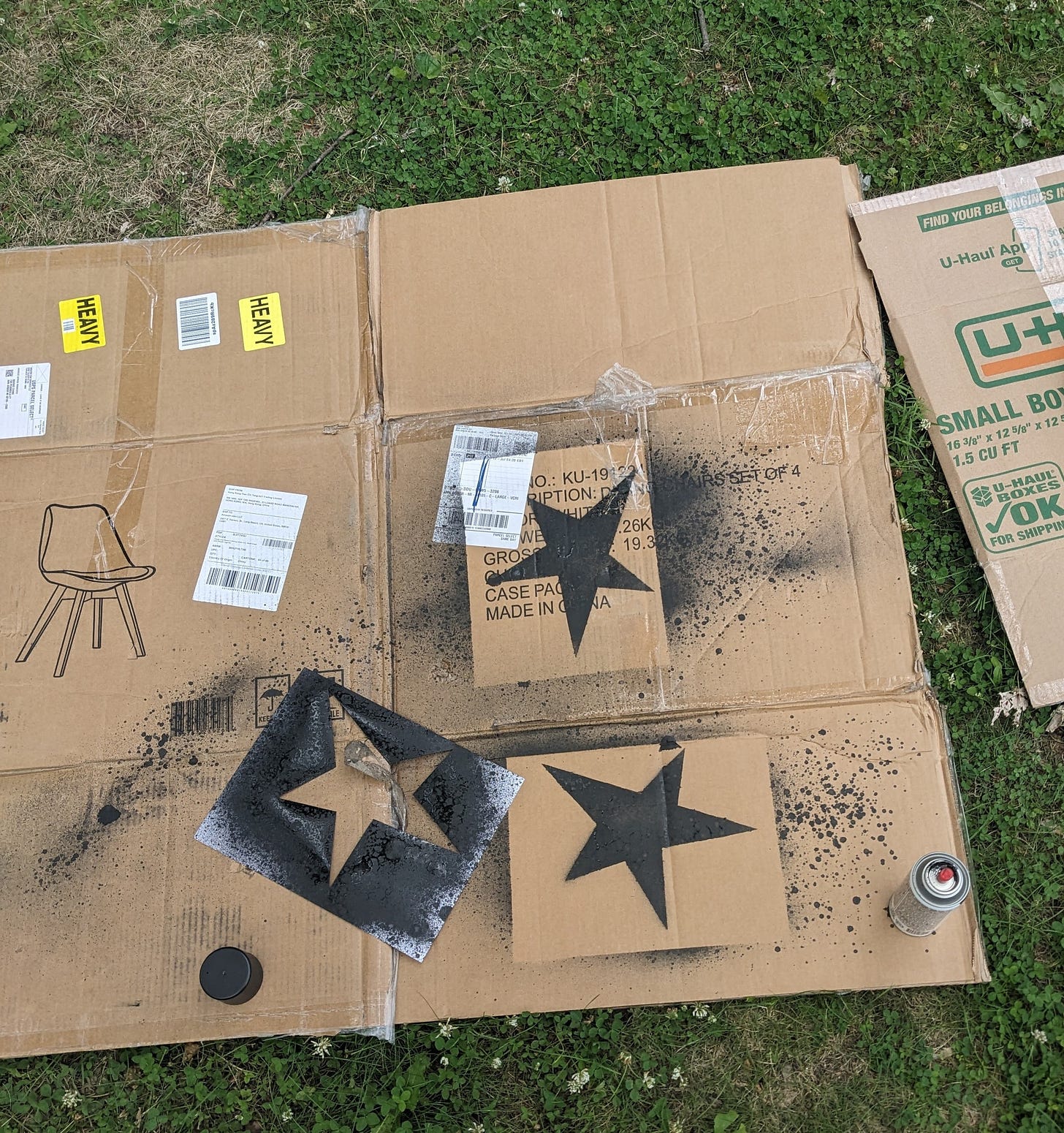Ben Moore Olympic Trials, the elephant in the room, entering the matrix
Listen up maggots, it's power hour
As a person with a high degree of discretion over how I spend my time, plan my projects and allocate my energy, I struggle with this question: how do I make those decisions?
Lately I have been experimenting with shifting my to-do list into Eisenhower Matrix format. This well-known chart divides tasks along two traits: urgent vs. not and important vs. not. I’ve been needing some help prioritizing, and with painting season in full swing I can’t afford to get behind on mural planning or to procrastinate things that will take a long time to get right. Left to my own devices – absent a deadline forcing me into action – I will generally prioritize not based on urgency and importance, but on what can be accomplished quickly (“what can I check off?”).
When everything lives on the same list, the brain automatically frames the goal as just shortening the list. Using this chart format certainly hasn’t revolutionized anything for me, but it is helpful simply to not have everything clumped together in the category of “has to get done.” I’ll never get to the stuff that takes longer or is more daunting in a timely way if I’m not constantly reminding myself – consciously but also visually – that some things matter more than others. It’s also simply easier on the ol’ brain to set my priorities just once per day or per week rather than having to make the decision of “what should come next?” every time I switch gears.
There are tons of templates and articles about this tool (including two I linked to above) but here’s a simple one you can copy right into your Google Sheets, xoxo.
All that being said
It’s still hard to get this ass in gear but it’s easier to do it onstage, so come along with me as I get through a curated list of tasks for this work-from-home weekend. (I’m visiting Travis in Michigan right now, and all my playmates are either out of town or resident doctors working night shifts.)
✅ Make something stupid
Personal work lately is neither critical nor urgent, however, the itch to work on something fun and “me” makes itself known from time to time. Rather than be distracted by it, today I warmed up with something from my product-design files. I took an old sticker idea from last year, swapped out the illustration, added a fun new Adobe font I noticed the other day, and messed around with color and textures.
This one goes out to all the comrades who also use easy and achievable tasks to avoid working on the meaningful but daunting stuff. 😎 More importantly:
✅ Pick out colors for my first two murals
I’m starting my first dance diagram mural in Lowell on Wednesday, and tackling a big mural in Roslindale Village the week after that. When I was just starting out muraling, I chose my paint colors at the store, with a digital file or print-out of my design in hand while I looked through the color chips. Several projects later, I realized that all paint brands list all their available colors online (duh). It’s still hard to find exact color matches, unless you designed your mural with existing paint colors in mind – or unless you’re willing to color-mix onsite, which I try hard to avoid – but it’s still way better than trying to compare and make decisions on-the-spot while shopping.
Here’s the mural design for Lowell – this one was choreographed by two student leaders of the Lowell High School Step Team. I still need to add the Spanish version of the instructions, but the colors and designs will stay as-is.
I’m so excited for this one!
I find color picking to be a highly procrastinatable task because it seems more straightforward than it really is. Which black, gray, red, gold, green and white should I get? Usually for any one color on my design there’s 2–3 available paint colors that are pretty close to what I have in my design, but none that is the obvious right choice. Nothing to do but fire up the Ben Moore color picker and fight it out.
My ground mural for the Birch Street Plaza in Roslindale uses only five colors, which was a highly intentional choice. I’ve gotten a bit stuck because there’s no great option for this deep, pungent violet I dreamed up in Procreate – the top cloud layer on the top, and the big wiggly line towards the bottom.
I’ve narrowed it down to Midnight Navy or Admiral Blue. Trust me when I say these are the two best options I could find, including from Sherwin Williams and Behr.
I can always add a touch of black to whatever option I go with to increase the contrast between that hue and the other colors. I think I have my Plan A – but I’m curious what you all think:
I love the Olympics
With these two daunting color-picking tasks completed – thank you, audience, for holding me accountable – we shall celebrate with the winner’s podium of Ben Moore’s most confusing color names du jour, blue edition:
The Moon Drops Was Already Taken award goes to Icy Moon Drops, #2056-70
The Hallmark award goes to New Born’s Eyes, #1663
The Burying a Cry For Help in your Employer’s Website award goes to How Blue Am I?, #752
And the award for Best All-Around Confusing goes to Soft Chinchilla, #2135-50, unless I am very off base about what color chinchillas are
✅ Practice using spray paint
I used stencils extensively in my first dance diagrams series. With Roslintrail, I was hand-tracing and cutting the big shapes (footsteps, text boxes, the big non-line motifs that sit on top of the background) out of cardboard in my studio so that I could trace them onsite at their correct dimensions. Much easier and faster for me than freehanding on the ground.
For my murals this summer, I have been planning to step up my use of that technique. The big stencils work pretty well (though I’d now use poster board or cardstock, not cardboard), but they don’t work for one of the elements that takes the longest to get on the ground – text. It would just take too long to cut them out by hand; it wouldn’t save me any time. So for the past few weeks, I’ve been looking around for a solution for making stencils of things like the mural credits (Kit Collins 2024, choreographed by X, supported by X City agency, etc.), the project website URL, and the dance instructions, so that I don’t have to hand-letter all of this each time.
To be clear, I have nothing against hand-lettering, I think it looks nice. I’m just making a personal choice to try and increase my speed wherever I can this painting season, because I want to be able to proceed as quickly as I can from one mural to the next. And for these murals, I think stencil text will look just as good.
After no small amount of research, I decided to invest in a Cricut machine. Using the Cricut, I can create digital files of the text (or whatever) I want to stencil, and have the machine automatically cut it onto a specialized stencil plastic or just into whatever poster board or cardstock I have around.
Since the goal is to speed up my onsite process, the next question was how to use my stencils – bringing me thus to trying out spray paint. I have seen many muralist friends use spray paint to great effect, but I have never really tried it and don’t have any confidence with the medium. Even though on these murals I wouldn’t be using it for blending or painterly effects – just point-and-spray to fill space – I wanted to get a little practice in before hitting my first mural site this week.
I don’t know what all that drippage is about – bad technique, or just a dud can? While it was good to try this out, I don’t know that it’s convinced me to use spray paint with the stencils. I used foam rollers on my little paper stencils for my recent window mural in Lowell (I’ll make a reel about that project eventually), and that worked just fine. The downsides to rollers are that it takes the paint a bit longer to dry than spray paint (it goes on thicker), plus that foam rollers are aren’t really reusable and I hate to run through a lot of them. I’ll probably mix and match the two techniques depending on what colors are available as aerosols.
⭕ What’s Next
Drawing projects: rough drafts for a freelance client; a rough draft for a mural in September (a vertical one – imagine!); and pushing forward my mural designs for the Brookline dance diagrams.
I find it very hard to draw during the day – I can focus on my drawing tablet way better during the nightly witching hours. If I can get through half of the above drawing tasks before 8pm today, that will be a personal victory.
Elephant in the room?
Is it weird to send out a newsletter the day after a presidential assassination attempt and not mention it? Or does mentioning it make it weird?
We’ve been on a bit of a run of clarifying political moments these past few weeks. It makes me ponder that distinction between a change in circumstances vs. a clarification of circumstances.
Did Biden’s actual ability as a candidate steeply drop off right before or during debate? I would say no, but it certainly clarified and broadcasted what we’re working with. Did Trump’s photogenic survival of an assassination attempt suddenly tilt the odds of victory towards his favor? I would argue no; I think it was already more likely than not that we’re looking at a second Trump term.
But these events sure feel like change. A change in circumstances – or a change in certainty, in expectations? Ultimately, it doesn’t matter; changes prompt us to react, and I think a lot of people right now are animated by that question of how we should react.
Grieving is a very normal reaction to horrible things happening. But personally I am taking a lot of solace and normalcy in the feeling that the ground beneath our feet has not, in fact, shifted and the needed work is the same as it was two days, two months, and two years ago. This work is not just to mitigate the harms that another Trump presidency would cause; but to do the still-emergent-no-matter-what work of building a society that actually supports and protects people. (Widespread crushing debt, shrinking social safety net and public sector, worsening extreme weather, Supreme Court willing to roll back civil rights and hard-won regulations, over-empowered corporations, are not going anywhere – even with Democrats in power.)
We still need to make collectivism and local organizing not only more accessible, but irresistible – more competitive with the other sources of fun and connection in our lives. It needs to be made easy and friendly to organize on your block, in your building, in your workplace. IMO, especially lately, the left has done too good a job at broadcasting the misery, the long hours, and self-sacrifice of the struggle. We need to do a much better job of fostering and broadcasting the joy, the appeal, and community of the work, too.
The stakes are just as high as they were a day ago – everything. Even if things go “well” in November, we still need to shore up our own local systems for mutual aid, emergency and disaster response, cash assistance, debt relief, food assistance, medical and immigration safe havens. A Trump defeat would back-burner this resurgent movement of fascism that is growing in America; but it will be back in an election cycle or two, when the next Trump surrogate is riding the political pendulum swing to dominance.
That’s a chilling thought for sure, but for me – maybe oddly – it helps me skirt that paralyzed feeling. I used to believe that we could turn the tide of history in a single generation if people like me just sacrificed hard enough. Now I find that mindset totally naive and besides the point. Many people are involved in political, tenant, union, basic needs organizing, etc. because their material conditions or lived experience leave them no choice. For everyone else, we have to make getting involved feel easy, compelling, welcoming, and joyful. Too much of political and community organizing is motivated by spasms of angst, guilt or shame. I do not think that is a winning strategy for knitting together the maximum number of people, for the long run, towards the goals of greater solidarity with our fellow humans and working to ensure that everyone can count on a safe and lovely place to live, medical care, good food, a good job, freedom from debt, and help when and where they need it, for them and their family.
Though I am cynical, I don’t mean this as a reasoning for doing less or caring less. Take it more as a reflection on how to make left movements into candles that burn the longest, not the ones that burn bright and burn out before they get a chance to pass the flame along. The left that will organically win more and more and more people into its ranks over the years will be obviously, visibly welcoming to people in all stages of life. It will be curious, not shaming. It will be big-tent. There won’t be perceived thresholds of political correctness or energy or availability that people feel like they need to clear in order to belong. It will include inexhaustible young guns who want to work around the clock, because they are unavoidable, but it will not hinge on them. It will have many doors in, many kinds of roles, it will be easy to stay in touch with. I am not close to the labor organizing world but I believe our best models will be found there.
Sorry that this has all gotten a little abstract. What I mean to say is, it’s not this election, this candidate, or doom. It’s this election and then everything that already needed to happen anyway. And we need to be prepared to welcome in everybody.
To strengthen community ties ahead of the next debacle, and to help our neighbors (local or national) get what they need in this era of federal and judicial hostility, we need to form our own networks. That can start with or involve high-profile electoral organizing, but our candidates aren’t anywhere good enough that it can end there. I get my inspiration from the normal people behind Mutual Aid Medford & Somerville, which started during the pandemic and has flourished into a still-active network of neighbors donating time, stuff and money to fill the gaps when other local people can’t afford to buy food or pay for rent, car repairs, utilities or an AC unit. They have a great but long History of Mutual Aid on their website. I recommend flipping down to the section on What Mutual Aid Can Look Like Now which has concrete examples.
And I think I’ve linked to this before, but I also highly recommend reading about The Incorruptibles, a project founded by my fellow City Councilor in Medford, Anna Callahan, which has tangible how-to’s and testimonies about building local political power. Despite my above emphases, electoral organizing is obviously an integral part of the formula, especially on the local level where people can work for and feel effects in their own lives. As always, if you or anyone you know has even an inkling of an interest in pursuing public office one day, email me. Seriously!
Don't give up. Don't despair. The work stays the same. We can make the movement for collective resiliency and safety into something joyful and irresistible. I just think more of us have to start looking at it that way.
Thanks for reading!
If you enjoy this newsletter, please consider forwarding to a friend, or supporting me with a paid subscription.









This comment is about the paint color - cause you know I went on BM and was looking and wondered if you put half gal of dark burgundy in admiral blue would you reach that purpleyness but maybe it’s not worth it but also :)
Meagan